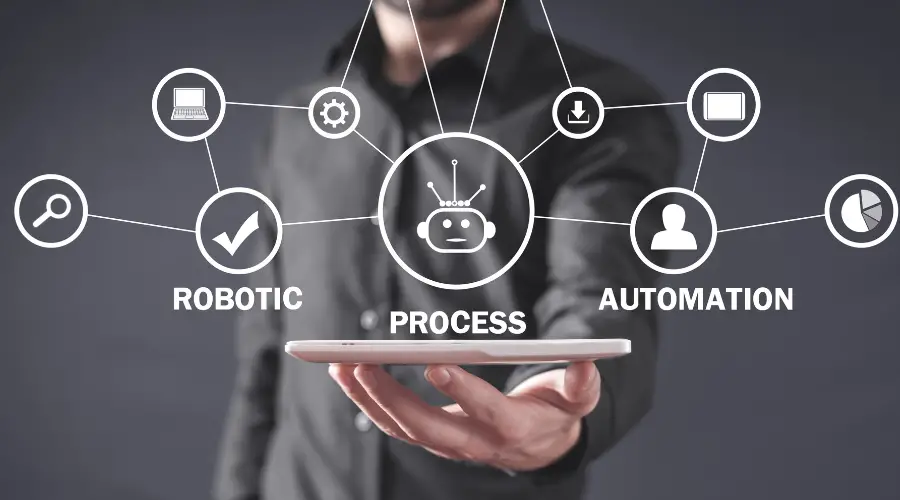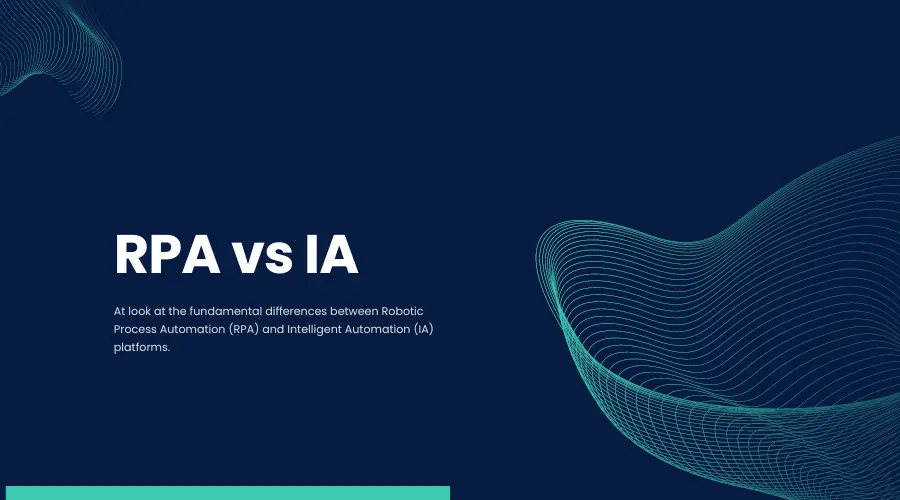The rise of Robotic Process Automation (RPA) has revolutionized industries worldwide by streamlining processes and boosting efficiency.
Businesses in a wide range of sectors, such as healthcare, finance, and manufacturing, have been adopting RPA technology to gather, process, and analyze vast amounts of data.
By automating repetitive, time-consuming tasks, RPA allows employees to focus on high-value work, driving growth and innovation.
One of the key aspects of RPA implementation is understanding its potential use cases. Identifying activities or processes that can benefit from automation can help companies maximize their return on investment.
Some common RPA use cases include data extraction, customer service assistance, and invoice processing. These applications of RPA have already demonstrated significant improvements in speed, accuracy, and cost reduction, prompting more businesses to explore the possibilities of RPA deployment.
In the following article, we’ll delve further into several prominent RPA use cases and explore the ways in which organizations have successfully leveraged automation technology.
By examining real-life examples, readers will gain a better understanding of how RPA can be applied in various industries to enhance productivity and optimize performance.
Fundamentals of RPA
Understanding Robotic Process Automation
Robotic Process Automation (RPA) is a technology that uses software robots to automate repetitive tasks, streamline processes, and improve efficiency.
RPA focuses on automating tedious and time-consuming tasks, enabling employees to focus on higher-value tasks and strategic initiatives.
RPA can be classified into three categories:
- Attended RPA: These robots assist human employees with their tasks, working alongside them on a shared computer.
- Unattended RPA: These robots operate independently without human intervention, typically in a server environment or virtual machine.
- Hybrid RPA: A combination of attended and unattended RPA, used for processes that require both human and robotic input.
The Role of AI and Machine Learning in RPA
Artificial intelligence (AI) and machine learning play a crucial role in enhancing RPA capabilities.
By incorporating AI and machine learning algorithms, RPA software can perform more complex tasks, learn from past experiences, and adapt to changing environments.
Some of these advanced capabilities include:
- Natural Language Processing (NLP): Analyzing human language, enabling RPA to understand and process unstructured data.
- Optical Character Recognition (OCR): Extracting text from images and documents, converting it into a format that RPA can process.
- Machine Learning: Allowing robots to learn from data and improve their performance over time, making predictions and classifications based on historical data.
Major RPA Vendors
There are several RPA vendors in the market, with Blue Prism and UiPath being two of the major players. Both vendors provide powerful and versatile RPA platforms that cater to different business needs.
Blue Prism: Blue Prism offers a comprehensive RPA platform, boasting robust security features and a strong focus on scalability. It provides a code-free, drag-and-drop interface that makes it easy for non-technical users to develop automation workflows. Blue Prism’s platform is particularly suited for large enterprises looking to scale their RPA initiatives.
UiPath: UiPath offers an intuitive and user-friendly RPA platform, making it a popular choice for businesses of all sizes. It boasts a vast ecosystem of pre-built automation templates and integrations, allowing for rapid deployment of RPA solutions. UiPath’s platform excels in providing flexibility and ease of use, catering to both technical and non-technical users.
RPA Use Cases Across Industries
Banking and Finance
In the banking and finance industry, RPA can streamline various processes, such as account opening, fraud detection, and customer support. It enables the automation of repetitive tasks like data entry and reconciliation, reducing human error and improving efficiency.
Healthcare
RPA has multiple applications within the healthcare industry. It can be used for patient data management, appointment scheduling, and processing insurance claims. By automating these processes, healthcare providers can focus on delivering better patient care.
For example, certain RPA platforms (such as Nividous) are designed to reduce manual work and improve efficiency and accuracy in healthcare settings by automating functions such as medical coding, billing, appointment setting and claims processing.
Manufacturing
In manufacturing, RPA can optimize production and supply chain processes. It can help automate inventory management, order processing, and quality assurance checks. This leads to increased productivity, reduced costs, and improved product quality.
Retail
RPA in retail can help businesses streamline their operations and enhance customer experience. Automation can be applied to inventory management, pricing, and order fulfillment processes. This reduces errors, increases efficiency, and ensures that customer needs are met effectively.
For example, with low-code RPA tools like Robomotion, retailers can with daily workflows and lead management activities by building automations between ERP and CRM systems and generating reports based on customer activities./
Telecom
The telecom industry can benefit from RPA by automating tasks such as billing, service activation, and customer support. It can also help with network monitoring and maintenance, ensuring better service quality and minimizing downtime.
Insurance
In the insurance industry, RPA can support processes like policy issuance, claims processing, and underwriting. Automating these tasks reduces the turnaround time, enhances accuracy, and enables insurance companies to better serve their customers.
RPA Applications in Business Functions
Human Resources
RPA can streamline HR processes through automation, such as onboarding, offboarding, employee data management, and leave request handling. By automating repetitive tasks, it reduces human error and frees up time for HR professionals to focus on more strategic initiatives.
- Onboarding: Automating the creation and distribution of employee accounts, orientation materials, and payroll setup.
- Offboarding: Handling resignation or termination processes, disabling accounts, and ensuring a smooth exit for employees.
- Employee Data Management: Ensuring accurate record-keeping of employee information, tracking changes, and generating reports.
- Leave Request Handling: Simplifying the approval process for vacation, sick leave or parental leave requests and updating records accordingly.
Sales and Marketing
RPA can enhance sales and marketing activities through lead generation, campaign management, and reporting and analysis. It can help identify potential customers, monitor marketing campaigns, and gather valuable insights.
- Lead Generation: Scraping, collecting, and organizing data from multiple sources to identify prospects, thereby increasing the chances of converting leads into sales.
- Campaign Management: Automating repetitive tasks such as scheduling social media posts, sending emails, and analyzing engagement to optimize marketing campaigns.
- Reporting and Analysis: Generating timely reports, evaluating performance, and identifying trends to adjust strategies.
Customer Service
In the customer service domain, RPA can improve response times and overall service quality. It can be utilized for process automation, ticket management, and customer feedback analysis.
- Process Automation: Automating responses to frequently asked questions, processing simple customer requests, and handling inquiries.
- Ticket Management: Streamlining the ticket creation, categorization, and prioritization process to resolve issues efficiently.
- Customer Feedback Analysis: Analyzing feedback and sentiment from social media, surveys, and other channels to identify areas of improvement.
Administration
RPA can be implemented in various administrative tasks, including invoice processing, expense management, and data entry, leading to greater efficiency and cost savings.
- Invoice Processing: Automating the processing and validation of invoices, ensuring timely payments and minimizing errors.
- Expense Management: Accelerating the review and approval process for expense claims, reducing administrative workload.
- Data Entry: Eliminating manual data input and minimizing human error in transferring data between systems.
Supply Chain Management
In supply chain management, RPA can optimize processes such as inventory management, order processing, and vendor management for improved operational performance.
- Inventory Management: Automating stock checks, reordering, and tracking to keep inventory at optimal levels.
- Order Processing: Expedited order entries, confirmation, and fulfillment through automation, leading to reduced lead times and increased customer satisfaction.
- Vendor Management: Streamlining supplier evaluation, performance monitoring, and communication for better vendor relations.
Key RPA Processes and Technologies
OCR and Data Extraction
Robotic Process Automation (RPA) encompasses several technologies, one of which is Optical Character Recognition (OCR).
This technology is capable of extracting data from physical or digital documents. By converting printed or handwritten text into digital text, RPA can efficiently automate data entry and reduce manual effort.
This proves valuable in various industries, such as finance, where data extraction from invoices, purchase orders, and forms streamlines operations.
Document Processing
Another significant technology in RPA is document processing. This involves using automation tools to receive, handle, store, and manage documents.
Applying RPA to document processing can improve accuracy and efficiency while reducing manual labor.
Examples include automatically processing insurance claims or updating employee records in human resources departments.
Additionally, automated workflows can route documents through predefined steps to ensure compliance and timely processing.
Web Scraping
Web scraping is the practice of extracting data from websites. RPA can automate this process, enabling organizations to gather information from multiple sources quickly.
This technology is commonly used to collect pricing data, business contact information, or industry news.
Web scraping with RPA provides businesses with the relevant data they need to make informed decisions, enhance their competitive advantage, or develop robust market research capabilities.
Integrating with ERP and CRM Systems
RPA is particularly adept at integrating with Enterprise Resource Planning (ERP) and Customer Relationship Management (CRM) systems. Integrating RPA with these systems can enhance organizational efficiency, improve data accuracy, and decrease human error.
For instance, robots can automatically update product information in ERP systems without manual intervention.
Similarly, in CRM systems, RPA can help maintain customer records, ensure timely follow-ups, and reduce response times for customer inquiries.
These integrations contribute to a smooth, seamless business process, ultimately benefiting both employees and customers while increasing productivity and reducing costs.
Improving Compliance and Security with RPA
Data Validation and Error Handling
RPA can significantly enhance compliance and security by automating data validation and error handling processes.
By employing bots, the risk of human error is minimized, leading to more accurate data management.
Bots can be programmed to identify and flag inconsistencies in data input, ensuring that they are addressed early on. This reduces the likelihood of passing inaccurate information through important workflows and helps organizations meet regulatory standards.
Additionally, RPA can deliver a robust error-handling mechanism. This can be beneficial in many industries where compliance is crucial.
For instance, in the financial industry, non-compliance may lead to significant fines and reputational damage.
Deploying RPA for error handling in such a context can thus contribute to improved security and compliance management.
Managing Privileged Data
RPA can also support organizations in managing privileged data. By automating access control and user authentication, RPA helps ensure that only authorized personnel can interact with sensitive information.
Privileged data can encompass customer information, trade secrets, or intellectual property, which must be protected to maintain a company’s competitive advantage and comply with data protection regulations such as GDPR or HIPAA.
Moreover, RPA bots can be programmed to adhere to specific data retention and disposal policies. Implementing such measures promotes compliance by eliminating the possibility of retaining data for longer than permitted or disposing of it inappropriately.
Data Transfers
RPA facilitates secure data transfers between different applications or systems. The automation of data transfers reduces instances of human error that might arise in manual transactions.
Furthermore, RPA bots can be configured to follow strict protocols when handling sensitive data, ensuring adherence to both security best practices and regulatory requirements.
Automating data transfers with RPA also enhances traceability and auditability. Detailed logs can be maintained, documenting each action taken by the RPA bot during a data transfer.
This helps organizations to quickly identify and respond to potential security issues, as well as provide evidence of compliance in the event of an audit.
Overall, RPA contributes to improved compliance and security by automating data validation, managing privileged data, and streamlining secure data transfers.
These benefits ultimately help organizations mitigate risks, maintain their reputation, and satisfy regulatory requirements.
RPA and Digital Transformation
Application in IoT and Cloud Technologies
Robotic Process Automation (RPA) has a significant role in Digital Transformation initiatives, especially when it comes to the Internet of Things (IoT) and Cloud Technologies.
RPA helps organizations automate repetitive tasks, enabling more efficient use of resources and allowing for better scalability.
In the context of IoT, RPA can be used to manage, monitor, and control large numbers of connected devices.
By automating routine tasks, such as data collection and analysis, RPA can help organizations make more informed decisions based on real-time information.
Moreover, integration of RPA with Cloud Technologies offers various benefits, such as:
- Better data storage and access
- Improved collaboration and communication
- Enhanced security and compliance
These benefits can improve overall efficiency and productivity of organizations and support their digital transformation journey.
RPA’s Role in Workload Automation and Network Management
Workload automation and network management are other areas in which RPA plays a crucial role.
With workload automation, RPA can streamline processes, ensuring timely completion of tasks and automation of routine maintenance tasks. This prevents human errors, reduces time spent on manual tasks, and increases accuracy.
In the area of network management, RPA can be used to monitor networks, detect and diagnose issues, and take corrective actions as needed. By automating these tasks, organizations can:
- Minimize downtime
- Improve performance
- Reduce operational costs
In summary, RPA is a vital part of digital transformation, and its applications in IoT, Cloud Technologies, workload automation, and network management provide organizations with numerous benefits.
These benefits can improve the efficiency and productivity of businesses, support their growth, and help them stay competitive in their respective industries.
The Future of RPA
Trends in RPA and AI Development
The development of Robotic Process Automation (RPA) and Artificial Intelligence (AI) continues to grow at an exceptional pace.
A major trend we can observe is the increased focus on efficiency and relevance. Organizations are now implementing RPA not only to streamline repetitive tasks but also to enhance the overall performance of their operations.
AI has become an integral part of RPA solutions, as chatbots and other intelligent tools have been developed to further improve business processes.
The market for AI-powered RPA solutions is projected to see continuous growth in the coming years, with industries such as finance, healthcare, and e-commerce capitalizing on this technology to boost their efficiency.
Addressing the Challenges of RPA Adoption
One of the challenges RPA faces is the need to develop a comprehensive understanding of business processes and their requirements. This necessitates the collaboration of domain experts and RPA professionals.
Overcoming this hurdle will enable organizations to adopt RPA effectively and align it with their business objectives.
Successfully implementing RPA also involves addressing the concerns of existing employees. Organizations should emphasize the value of RPA as a supportive tool rather than a replacement for human workers.
Team members must recognize RPA as a technology that will empower them to focus on more strategic and rewarding tasks, while the automation handles mundane activities.
| Developing RPA Solutions | Challenges | Solutions |
|---|---|---|
| Efficiency and relevance | Comprehensive understanding of business processes | Collaboration of domain experts and RPA professionals |
| Chatbots and AI integration | Addressing employee concerns | Emphasizing RPA as a supportive tool |
In the future, we can expect RPA to be a crucial pillar of any organization’s digital transformation journey.
Addressing the challenges that come with RPA adoption and keeping pace with trends in RPA and AI development will be essential for organizations to harness the full potential of this technology.



